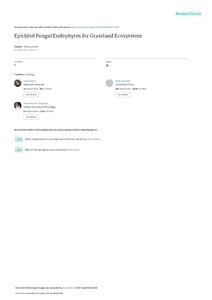Epichloë fungal endophytes for grassland ecosystems
Hume DE; Geraldine DR; Gibert A; Helander M; Mirlohi A; Sabzalian MR
https://urn.fi/URN:NBN:fi-fe2021042720054
Tiivistelmä
The Epichloë fungal endophytes that inhabit grasses have potentially large-scale consequences for macro- and micro-organisms and food chains in agriculture. Over 40 years of study on the benefits of symbiotic Epichloë fungal endophytes for host grasses, investigations have focused on the major agricultural species, tall fescue and perennial ryegrass. However, many other grass species remain to be evaluated for the effects of Epichloë endophytes. Animal toxicity due to accumulation of nitrogenous compounds, e.g. endophyte-dervived alkaloids, particularly in areas and periods under abiotic stress, still prevent widespread application of endophyte-infected grasses in agroecosystems. Here we review Epichloë endophyte-ecosystem relationships. The major points are: (1) Epichloë endophytes protect their host plants from vertebrate and invertebrate herbivory and allow plants to persist under water shortage, salinity, low light, mineral deficiencies and metal toxicity. Data suggests that the concentration of endophyte-derived anti-herbviore compounds increases with rising temperatures. This trend thus suggests that the strength of mutualistic interactions may increase in future climates with possible consequences for animal toxicity. (2) The benefits of endophyte infection for the host grass are context-dependent, varying with
environmental conditions, grass species and cultivar, and are also highly influenced by interactions between both host and endophyte genetic combinations. (3) The benefits of fungal endophytes extend to neighboring grass species with respect to their protection from diseases and herbivores. (4) Novel grass-endophyte associations that produce alkaloids reducing herbivory insects, but do not produce alkaloids that are toxic to grazing vertebrates have been found. Such associations are therefore useful to control plant pests and diseases.
Kokoelmat
- Rinnakkaistallenteet [27094]
